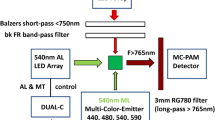Summary
The UV-B radiation (e.g. 337 nm) induced blue fluorescence (BF) and red chlorophyll fluorescence spectra (RF) of green leaves from plants with different leaf structure were determined and the possible nature and candidates of the blue fluorescence emission investigated. The blue fluorescence BF is characterized by a main maximum in the 450 nm region and in most cases by a second maximum/shoulder in the 530 nm region. The latter has been termed green fluorescence GF. The red chlorophyll fluorescence RF, in turn, exhibits two maxima in the 690 and 730 nm region. In general, the intensity of BF, GF and RF emission is significantly higher in the lower than the upper leaf side. The ratio of BF to RF emission (F450/F690) seems to vary from plant species to plant species. BF and GF emission spectra appear to be a mixed signal composed of the fluorescence emission of several substances of the plant vacuole and cell wall, which may primarily arise in the epidermis. Leaves with removed epidermis and chlorophyll-free leaves, however, still exhibit a BF and GF emission. Candidates for the blue fluorescence emission (λ max near 450 nm) are phenolic substances such as chlorogenic acid, caffeic acid, coumarins (aesculetin, scopoletin), stilbenes (t-stilbene, rhaponticin), the spectra of which are shown. GF emission (λ max near 530 nm) seems to be caused by substances like the alkaloid berberine and quercetin. Riboflavine, NADPH and phyllohydroquinoneK 1 seem to contribute little to the BF and GF emission as compared to the other plant compounds. Purified naturalβ-carotene does not exhibit any blue fluorescence.
Similar content being viewed by others
References
Beggs CJ, Wellmann E, Grisebach H (1986) Photocontrol of flavonoid biosynthesis. In: Photomorphogenesis in plants. Nijhoff, Dordrecht, pp 467–499
Buschmann C, Prehn H, Lichtenthaler HK (1984) Photoacoustic spectroscopy (PAS) and its application in photosynthesis research. Photosynth Res 5:29–46
Caldwell MM (1981) Plant responses to solar ultraviolett radiation. In: Lange OL, Nobel PS, Osmond CB, Ziegler H (eds) Encyclopedia of plant physiology, New Series 12 A, Physiological plant ecology, I. Springer, Berlin Heidelberg New York, pp 169–197
Chapelle EW, Wood FM, McMurtey YE, Newcomb WW (1984) Laser induced fluorescence of green plants. 1: a technique for remote detection of plant stress and species differentiation. Appl Opt 23:134–138
Chapelle EW, McMurtey YE, Kim MS (1990) Laser induced blue fluorescence in vegetation. In: Proc Internat Geoscience Remote Sensing Symposium IGARSS'90, vol 3. University of Maryland, Washington DC, pp 1919–1922
Förster T (1951) Fluoreszenz organischer Verbindungen. Vandenhoeck & Rupprecht, Göttingen
French CS (1960) The chlorophylls in vivo and in vitro. In: Ruhland W (ed) Handbuch der Pflanzenphysiologie, vol 5/1. Springer, Berlin Heidelberg New York, pp 252–297
Goulas Y, Moya I, Schmuck G (1990) Time-resolved spectroscopy of the blue fluorescence of spinach leaves. Photosynth Res 25:299–307
Hak R, Lichtenthaler HK, Rinderle U (1990) Decrease of the chlorophyll fluorescence ratio F690/F730 during greening and development of leaves. Radiat Environ Biophys 29:329–336
Harborne JB (1973) Phytochemical methods. Chapman and Hall, London
Harborne JB (1964) Biochemistry of phenolic compounds, chap 7, p 256; chap 13, part IV and V. Academic Press, New York
Harborne JB, Turner BL (1984) Plant chemosystematics, chap 7: Plant pigments. Academic Press, London, pp 128–179
Hegnauer R (1989 and 1990) Chemotaxonomie der Pflanzen, vols 8 and 9. Birkhäuser, Basel
Hermann K (1959) Caffeic and chlorogenic acid. Pharmazie 11:433–448
Hörhammer L, Scherm A (1955) Über das Vorkommen zyklischer Pflanzensäuren bei einigen Polygonaceen und Betulaceen. Arch Pharm 60:441–447
Interschick-Niebler E, Lichtenthaler HK (1981) Partition of phylloquinoneK1 between digitonin particles and chlorophyll-proteins of chloroplast membranes from Nicotiana tabacum. Z Naturforsch 36c:276–283
Karrer W (1958) Konstitution und Vorkommen der organischen Pflanzenstoffe. Birkhäuser, Basel
Kohnen K (1908) Fluoreszenz (KAYSER Handbuch der Spektroskopie Bd. IV). Leipzig 1908
Lichtenthaler HK (1968) Die Verbreitung der lipophilen Plastidenchinone in nichtgrünen Pflanzengeweben. Z Pflanzenphysiol 59:195–210
Lichtenthaler HK (1987) Chlorophylls and Carotenoids, the pigments of the photosynthetic biomembranes. Methods Enzymol 148:350–382
Lichtenthaler HK, Pfister K (1978) Praktikum der Photosynthese. Quelle & Meyer, Heidelberg
Lichtenthaler HK, Rinderle U (1988) Role of chlorophyll fluorescence in the detection of stress conditions in plants. CRC Crit Rev Anal Cbem 19, [Suppl I]:S29-S85
Lichtenthaler HK, Stober F (1990) Laser-induced chlorophyll fluorescence and blue fluorescence of green vegetation. In: Proc 10th EARSeL Symposium Toulouse 1990, EARSeL, Boulogne-Billancourt, pp 234–241
Lichtenthaler HK, Stober F, Buschmann C, Rinderle U, Hak R (1990) Laser-induced chlorophyll fluorescence and blue fluorescence of plants. In: Proc Internat Geoscience Remote Sensing Symposium IGARSS '90 vol 3. University of Maryland, Washington DC, pp 1913–1918
Lichtenthaler HK, Karunen P, Grumbach. KH (1977) Determination of prenylquinones in green photosynthetically active moss and liver moss tissues. Physiol Plant 40:105–110
Lichtenthaler HK, Hak R, Rinderle U (1990) The chlorophyll fluorescence ratio F690/F735 in leaves of different chlorophyll content. Photosynth Res 25:259–298
Luckner M (1989) Secondary metabolism in microorganisms, plants and animals, 3rd edn. Springer, Berlin Heidelberg New York
Politis J (1948) Sur la distribution de l'acide chlorogenic dans la famille des Solanacées at dans les organes de ces plantes. CR des Séances Acad, Paris 226:692–693
Theisen AF (1988) Fluorescence changes of a drying maple leaf observed in the visible and near-infrared. In: Lichtenthaler HK (ed) Applications of chlorophyll fluorescence. Kluwer, Dordrecht, pp 197–201
Van Brederode J, Steyns J (1985) UV-microscopic studies on the vacuolar changes caused by the flavone “aglycon” isovitexin inSilene pratensis plants. Protoplasma 128:59–63
Author information
Authors and Affiliations
Rights and permissions
About this article
Cite this article
Lang, M., Stober, F. & Lichtenthaler, H.K. Fluorescence emission spectra of plant leaves and plant constituents. Radiat Environ Biophys 30, 333–347 (1991). https://doi.org/10.1007/BF01210517
Received:
Accepted:
Issue Date:
DOI: https://doi.org/10.1007/BF01210517




